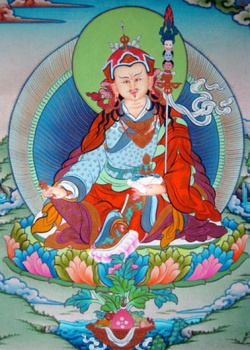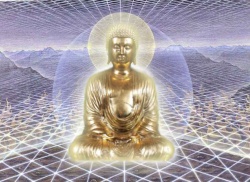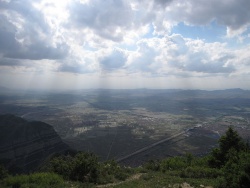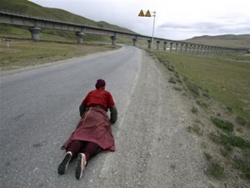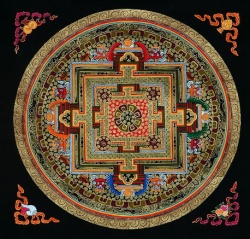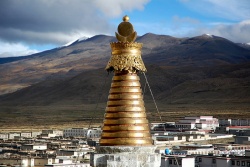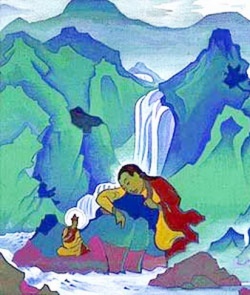The Relevance and Implications of the Three Core Characteristics of Existence, Impermanence, Unsatisfactoriness and Non-Self, in Buddhist Teachings for the 21st Century Multicultural Australia by Chand R. Sirimanne
The Relevance and Implications of the Three Core Characteristics of Existence, Impermanence, Unsatisfactoriness and Non-Self, in Buddhist Teachings for the 21st Century Multicultural Australia
Chand R. Sirimanne, University of Tasmania, Australia
The relevance and implications of the three core characteristics of existence, Impermanence, Unsatisfactoriness and Non-Self, in Buddhist teachings for the 21st century multicultural Australia.
Impermanence, Unsatisfactoriness and Non-Self of all existence in every realm and sphere is what the Buddha discovered at Enlightenment. The true understanding of this ultimate reality is in fact part and parcel of the Four Noble Truths and the Eightfold Path that lead to complete liberation from all conditioned existence and suffering. However, despite the fundamental importance of this characterization of samsara or the beginningless and endless wheel of existence, they are often airbrushed in presenting Buddhism to the West including in Australia.
With the increasing influence of Buddhism in the West in general and particularly in Australia, especially in the fields of ecology and psychology, it is interesting to observe how Buddhist teachings and doctrines are perceived, adapted and adopted just as it was done while spreading throughout Asia absorbing or adapting to existing cultural norms and belief systems in different regions. However, in many ways the 21st century West is alien soil indeed for Buddhism as it originated close to 2,600 years ago in a simple agrarian society in what is today Nepal. Can such an ancient belief system declaring that life is transient, essentially unsatisfactory, and that the core delusion is the concept of the self be relevant and acceptable today in the West and in Australia dominated as it were by science and technology, economic rationalism, galloping consumerism and the celebration of individuality?
Modern Australia established by the Europeans is one of the youngest nations in the world, and according to statistics the most multicultural country. Multiculturalism itself is perhaps the biggest social experiment in human history – an attempt by close to 250 nationalities and cultures to live in harmony under one flag. On the surface it is certainly a dynamic, wealthy and peaceful country offering a good life. Nevertheless, the above mentioned characteristics are undoubtedly there for anyone willing to see them. They manifest themselves in the catastrophe-prone ancient landscape itself, the history of the Aboriginal people, the terribly harsh and precarious beginning of European settlement, and the ever-changing kaleidoscope of Australia’s societal makeup with its undercurrents of resentments, tensions and fears.
The only concept unique to Buddhism and at its heart is Non-Self – the lack of any abiding soul, personhood or identity in anyone or anything. It could be said that our continuing discussion about an uncertain national identity is a broader societal reflection of the Buddhist concept of Anatta or Non-Self.
Although many of the issues discussed in this paper could be applied to almost any Western nation, Australia offers a unique and complex set of circumstances: Its geographical location among Asian countries and yet separated as an island continent, originally inhabited by the oldest civilization in the world going back over 60,000 years, but the modern Australia established by Europeans is one of the youngest nations in the world. It is the most ancient of continents with its unique flora and fauna with natural disasters such as bush fires, droughts and floods occurring almost on a regular basis, and in fact actually necessary for the renewal of much of its flora. Then, there are the still unresolved issues between black and white Australia, its current status as the most multicultural nation with waves of migration from all over the world since the end of the White Australia policy with high levels of tolerance and acceptance overall yet with occasional and isolated bursts of racism and paranoia.
The observation and in-depth comprehension of the three characteristics, impermanence, unsatisfactoriness and non-self of existence are fundamental to the understanding of the entire Buddhist doctrinal, philosophical, ethical and salvific frameworks, and they shape the Buddhist perspective of the human mind, matter and the entire cosmos.
To define these three characteristics very briefly, Anicca is described in the Pali Canon as:
- “Impermanence of things is the rising, passing and changing of things or the disappearance of things that have become or arisen. The meaning is that these things never persist in the same way, but that they are vanishing and dissolving from moment to moment.”
It is the basic characteristic of all conditioned phenomena – material and mental, the inner as well as the external reality. Therefore the totality of existence is impermanent as all formations are transient and the only unconditioned element is Nibbhana - the cessation of existence.
Dukkha, the second characteristic of Samsara and also the first Noble Truth used to be translated as suffering. Suffering is a somewhat inaccurate term as it implies a negation of any pleasure or joy in any form in life. Apart from this, suffering is perceived to be a word almost guaranteed to repulse today’s Westerners and the Westernized alike and particularly the young. Anyway, Unsatisfactoriness has become the more widely accepted term and I will use it here. It is categorized into three: (1) actually felt bodily or mental feeling of pain (2) the unsatisfactory nature of all formations of existence because of their continual arising and passing away (3) the bodily and mental feelings of pleasure which in turn cause pain when they come to an end. Buddhism has often been criticized for having a dark, negative perspective on life since essentially existence in every form or realm is deemed to be unsatisfactory. But there is acknowledgement of the existence of sukkha or pleasure, physical, mental and emotional, in numerous aspects of life – but this is precisely what entraps beings in samsara unable or unwilling to understand the transient and unsatisfactory nature of all pleasure, and above all mistaking the ego or personality that experience it to be a concrete entity.
Anatta is the last of the three characteristics of existence and means non-self, egolessness or impersonality – essentially the absence of a concrete and unchanging identity, personhood or soul in anyone or anything. This is the central doctrine as well as the most difficult concept at the heart of Buddhism and unique to Buddhism. If there is no soul or an abiding entity what actually traverses Samsara from life to life? The simple answer is that it is a process – not an entity as there is nothing of any substance in it. It is a stream of never-ending thoughts (mostly delusions) and actions (both mental and physical) that flow on and on changing from moment to moment, and from life to life. Thus, there is no ‘transmigration’ of a soul in the process of rebirth but a stream of consciousness that through its kammic volition creates its destiny as different beings in different realms and worlds. Buddha literally means the Awakened One – one who sees inner and external reality clearly without the defective filter of the ego/self, and it is the ignorance or lack of understanding of these three characteristics that keep beings trapped in the cycle of birth and death. In today’s world, particularly in prosperous countries, we do our level best to ignore this characterization of existence and in fact at face value these three seem to present an almost nihilistic view of life.
Superficially these three characteristics of samsara, impermanence, unsatisfactoriness and non-self, may seem out of place in the 21st century West where relatively long periods of peace and prosperity and an emphasis on the enjoyment of life and consumerism hides the signs of suffering so obvious in poor countries. But on the other hand, the all-pervasive media and the 24 hour news cycle make it in many ways easier than any time in our history to observe the misery of Samsara even in the comfort of one’s home. In this era of constant change and upheavals in every aspect of life, impermanence too is difficult to ignore unless one wants to. However, it is anatta or non-self that is the sticking point for a civilization based on individuality and a time when so much emphasis is laid on the freedom to satisfy all desires, and despite the world becoming a global village and connecting with others the easiest it has ever been, yet the divisions and the concept of the Evil Other do not seem to have weakened, as the delusion of self extends to our tribes – ethnic, racial and national.
Meditation or the development of the mind is the highest rung of the path to enlightenment in Buddhist teachings as the mind is the core of all things.Today in Australia as well as in the West generally the greatest influence of Buddhism can be seen in the field of psychology. The interface between Buddhism and Western psychology is essentially finding a solution to the question of human suffering although the ultimate goal and the approach are very different in scope. Over the last few decades mindfulness meditation has become a widely accepted therapeutic tool among an increasing number of psychotherapists in combination with other more traditional methods. Yet for all its popularity and acceptance the use of meditation as a psychotherapeutic tool is still very limited, and it is mindfulness meditation that is the main focus, used commonly as a rather disembodied therapeutic tool divorced from its source – the doctrinal, ethical and philosophical framework of Buddhism. There are many reasons for this, and it is not possible to discuss these in this paper. However, it should be pointed out that the underlying purpose of this is essentially to step back from the ego and its many delusions and in turning the attention from the external stimuli to the internal world one gradually becomes aware of the transient and essentially unsatisfactory arising and passing away of both physical, mental and emotional phenomena, which in turn help reduce the overwhelming size of the ego and thereby break down the barriers between the so-called Self and Others. In fact, every type of meditative practice in Buddhism, whether the meditative object is the breath, the body, loving kindness, kasina, asuba or the elements, the fundamental goal is ultimately the reduction of the ego through the observation of impermanence, unsatisfactoriness and non-self, as it is the mind that displays these characteristics so clearly. This observation could then be expanded to our family units, communities, societies, cultures and nations and finally to this third rock from the sun, the Earth and beyond to the unstable universe.
Although we may have misgivings about accepting this characterization of life interestingly enough today’s scientific knowledge support this view. Physicists today point out that the universe itself is unstable, expanding every moment and that 70% of it is dark matter of which we are still totally ignorant. The current theories include that there may be many universes rather than one – multiverses, and that we and everything else in the universe may actually be mere holograms – projections from the edge of the universe, very much in tune with ‘All is maya’ of the Buddhist perspective. Science has also established that we like all matter are made up of tiny, swiftly moving subatomic particles, and modern science has moved away from the Cartesian duality to accept non-duality of all things, and the interconnectedness of all living things can clearly be established when we observe the ecology of the Earth and the effect that the tiniest living organism has on the whole planet. Biologists have also established that we share around 98% of DNA with chimpanzees and 60% with even the humble fruit fly. Mainstream Western psychology still has some way to go before accepting Anatta but the general trend is moving towards that.
Thus, it is clear that this characterization of existence is not based on any religious perspective or hippy spirituality but on concrete, hard reality, and its observation within oneself and in the external world is not designed to make one depressed or frightened but to liberate the mind from its narrow, suffocating cage that is the personality view. It is the ultimate big picture that brings a true perspective to all the problems of mind and existence.
Coming back to the smaller picture that is Australia of today, how can this characterization be applied in a positive way? From my own observations, I would say that the majority of Australians possess a good understanding of Anicca or Impermanence – withstanding the many vicissitudes brought on by natural disasters with a stoic attitude. It is an acceptance of the many natural disasters that befall this ancient land on a regular basis – the terrible bushfires that destroy everything on their paths, prolonged and terrible droughts and equally destructive and unpredictable floods. It is this understanding and acceptance of Impermanence that help those affected to let go of what has been lost and also generate compassion for others – the essence of mateship.
On the other hand, there is more difficulty in accepting the rapid changes to Australian society as they have been many and it is comparatively still early days for full and universal acceptance of multiculturalism. As mentioned earlier, multiculturalism is perhaps one of the greatest social experiments in history as human beings are hard-wired to distrust and fear those outside their racial, ethnic and tribal group. Unlike such policies, unlike the environmental conditions, are seen to be imposed from above – governments. The fundamental delusion of the self creates hatred, greed and ill-will, which in turn expands to our tribal group creating the fear of the Others. We live in fear of the Other as individuals, families, communities, societies and nations. We live in terror that our culture, language and ethno-racial group is being gradually swamped and wiped out. In Australia we constantly look over our shoulders at our Asian neighbours fearing their taking over our country or being swamped by migrants and asylum seekers. In Canada, despite sharing the longest undefended border with the USA, they live in anxiety and suspicion about mad Uncle Sam next door eyeing their natural resources. In Sri Lanka we live in a permanent state of paranoia about our Big Brother India and we Sinhalese have been dying out for centuries. The universal stereotypical view of minorities is that they breed like rabbits for the specific purpose of taking over and the stereotype of the majority in charge is that they are stupid, lazy, racist, and hog the resources. It is these fears, ill-will and wrong views that serve as a great boon for unscrupulous politicians as they can be exploited so easily and dangerously. All wars, genocidal maniacs and arms dealers depend on this primal fear of the evil Other, the barriers between various groups, and considering this fundamental fear, Australia has done remarkably well absorbing wave upon wave of migrants from every corner of the world with relative grace.
Australia, being the most multicultural nation on the planet is indeed a nation of migrants – everybody except for the indigenous peoples came by boat or air in relatively recent times. The large scale migration of people started in the 20th century and has escalated in the 21st century as a result of wars, displacement and natural disasters as well as government policies of countries such as the USA, Canada, Australia and New Zealand. Most migrants are forced to acknowledge the characteristic of Impermanence as they leave their countries of birth for whatever reasons. Just as there are many success stories among migrants, there are even more failures. It is a difficult process to adapt to a completely different environment and those who succeed are those who can accept Anicca and a good deal of Dukkha as well. For the reality of the new, adopted country often falls short of the imagined great expectations before arrival or the first stage of settlement. Often adults feel as if they’ve become children again – learning a new language, trying to grasp strange cultural norms and traditions, but children cope much better with their flexible mind without many calcified pathways.
Apart from the practical difficulties of settling into a new environment, it is the mind that creates or amplifies the problems – the inability to let go of the former life and the weight of cultural baggage that leave little room for new furniture. It is the craving for what used to be and often seen through rose-coloured glasses, just as countries sometimes look back at a glorious past that never probably existed. Children of migrants are often caught between two worlds – the one outside their home and the one within created by their parents. The notion of a strong and inflexible cultural and ethno-racial identity often creates much grief and it is the real or perceived cultural differences that contribute to the barriers even more than linguistic barriers.
The nature of the Australian national identity has always been problematic and a continuing topic of debate and discussion as the cultural and history wars have freshly broken out yet again over school curriculums as they do here from time to time. Some argue that the great injustices done to the Indigenous people and their dispossession should be given more emphasis particularly in the education of our young. The other side argues that although this topic should certainly be included, the focus should be the positives brought about by European settlement and the many achievements of modern Australia. It is not an issue easily resolved as reconciliation is still an ongoing process with the Aboriginal population being the most disadvantaged group in our society despite the steps taken by successive governments, both federal and state, often with good intentions but without much success.
At the core of this issue is the immense chasm that separates the Aboriginal and the Western perspectives on life in general, land and ownership and what constitute development. From the very superficial knowledge I possess of the Aboriginal belief system, it seems that there are some parallels to the general Buddhist outlook: The belief that everything is interconnected and that nature and the planet too are living entities rather than mere resources for us to use. Living from day to day using only what one truly needs and possessing the barest essentials seem to describe at least some aspects of the lifestyle of a Buddhist monk or the Middle Path. The markers for development and civilization in Western terms on the other hand are ever increasing wealth, buildings, institutions, technologies and regulated life styles where success and happiness are often measured by what one possesses in both assets and status. It is also important to note that Aboriginal Australia too consisted of many different peoples with their own unique languages and cultural traditions.
On the other hand, without a doubt the European traditions have brought many benefits to this land too – democracy, the rule of law and the fruits of science and technology helping to improve the level of health, wellbeing and creature comforts in this rough and often unforgiving land and a culturally diverse and a richly complex society brought about through successive waves of migrants from all over the world. In both the East and the West we place enormous value on history, culture and traditions. We fervently believe that we can and should learn from history and that it is our cultural heritage and traditions including our language and religion that make us what we are. Yet obsessing about history also often mean holding on to grudges and resentments that in turn demand retribution and revenge. Buddhist meditative practice requires us to let go of the past and also the future and to focus exclusively on the present as that is the only thing of any value as neither our personal memories nor our cultural or racial memories are totally accurate as the flawed filter of our individual and cultural identities distort the reality at least to some extent.
Many complain about the lack of ‘culture’ in the young nations such as Australia, Canada and New Zealand, but it is noteworthy that these are three of the most liveable countries in the world today, though far from being perfect. From a Buddhist perspective, it is good not to have a strong and set national identity as it invariably crosses the line to chauvinism, ethno-centricism and toxic nationalism with undertones of racial, linguistic and cultural superiority and the fear of and contempt for those who are outside the tribe. Compassion, compromise and hybridity are what the Buddhist ethos suggests. Multiculturalism is essentially a rejection of purity as a delusional and often dangerous concept when applied to race, culture, language or religion. Hybridity and the tolerant flexibility and fruitfulness that comes with it is almost always a positive thing for not just plants and animals but for people and societies too. The only purity that Buddhism promotes is the purity of mind, intent and actions, and the only unconditioned and therefore pure state according to Buddhist teachings is Nibbhana.
We debate whether we should become a more integral part of Asia or hold on firmly to our European roots? Let go of the Queen or keep her? Is our best friend the USA or China? Should we have, as Jerry Seinfeld said on his visit here, the Union Jack at night on our flag or a kangaroo with green and gold? Or adopt the Aboriginal flag? Perhaps a Buddhist view would be why not all of the above? Or a deeper question could be, why do we even need a flag except perhaps for waving it at sporting events? From a truly Buddhist perspective the lack of a solid national identity is a positive thing – a reflection of the concept of Anatta at a national level. Buddhism negates all concepts of duality and the internal and external, the individual and the environment are all part of the same flux of life.
Dependent origination, kamma and anatta make nationality, race and ethnicity, caste and social status utterly redundant as according to Buddhism one spends countless life times in every conceivable body type, and one’s kamma (both good and bad) is the volitional force of thoughts and actions that shapes each birth. Snobbery, ethonocentricity, racism and nationalism can therefore be classified as the outer layers of maya (delusion) that one possess as individuals, communities, societies and even countries.
There is no doubt that Buddhism has benefited greatly from the West – its interest, scholarship and analytical approach has certainly rejuvenated it as a whole helping to uncover its core doctrinal base wiping away the cobwebs and dust of superstitions, rituals and culture-specific beliefs and prejudice in countries where it had taken root many centuries ago. It is however a pity if the West picks and chooses only the aspects of Buddhism that they find pleasant or acceptable such as tolerance, compassion and therapeutic tools. Buddhism cannot be categorized as just a religion, philosophy, a set of ethics, psychology or a salvific path. It is a combination of all of these things and more. The three fundamental characteristics of existence, Anicca, Dukkha and Anatta are both universal and timeless in their relevance and essential for the understanding of Buddhism and benefiting from it.
Source
By Chand R. Sirimanne, University of Tasmania, Australia
The third International Conference Buddhism & Australia 2014
